This story is published in partnership with Ozarks Alive, a cultural preservation project led by Kaitlyn McConnell.

SPRINGFIELD — Dulcy Stewart paints not with a brush, but with a hook.
Her rug-hooking work — showcasing colorful flowers, animals and scenery — grew out of a foundation of creation she learned as a child growing up around Kansas City. Her parents were artistically inclined, leading to Stewart’s own skills in painting, needlework and textile art.
“I always dabbed in other (art) things — I was like painting or painting even walls and doors and things like that,” she says. “Because I grew up with a mom who did that type of stuff — when you got home from school, you didn’t know what’s was going to (have happened at home). You might like it, you might not.”
Her skills and interest largely were put on hold as she entered adulthood and became a teacher. After moving to the Ozarks, about 20 years ago she visited a fiber store in Springfield with the plan of resuming her needlepoint hobby.
Browsing the store, however, sent her home with something she didn’t expect: a desire to try rug hooking, found by seeing some mats hanging on the wall.
She didn’t initially know how they were created, but later learned of the art form, which manifests by pulling loops of fabric or yarn through material to create images. It crosses cultures and centuries, and in the United States, it dates back to colonial times.
Looking back at the craft
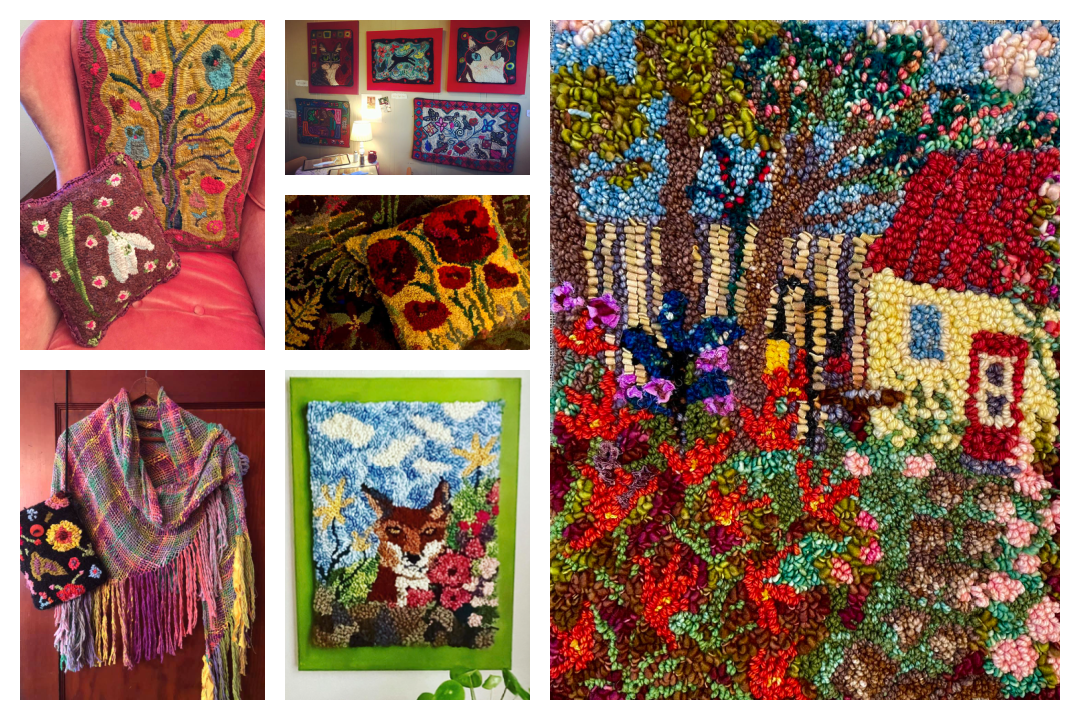
While rug hooking had an earlier start in the northeastern United States, it has been present in the Midwest for going on two centuries.
Perhaps its regional visibility is not as great as other crafts, notes Mary Collins Barile, author of “Hooked Rugs of the Midwest,” when compared with efforts like quilting or weaving, which could use large equipment and a group effort.
“Hooked rugs were one of the least demanding crafts found in the Midwest,” she writes in the book. “The rug hooker required little equipment — a quilt hoop or an unused picture frame to hold the foundation, a crochet hook set into a handle or a simple bent nail and worn-out fabric torn into strips. The rug maker used the cast-offs from other projects to produce an object that was most at home underfoot. It was a neighborly craft, but it did not require the assistance of other rug makers to succeed. And the rug was created as a utilitarian floor covering, subject to muddy, wet and thorough tromping from boots, feet and paws.”
Yet perhaps, at least in some ways, they provided a way to add a touch of beauty to life.
“Pioneer women did not have nice rugs and things for their homes,” says Stewart. “So they would buy potatoes or rice or something like that in a burlap bag, and then they would draw with a piece of charcoal some flowers or something. Then the old clothes that would accumulate, they would cut up and hook.
“As time moved on, pattern salesmen somehow developed where they’d come around with a drawn pattern, maybe on a piece of linen, and then people would buy that and hook. It was really kind of a primitive craft, and it still is.”
According to information from Missouri State Parks, rug hooking was promoted by the federal government during the Great Depression as a way for women to make extra money.
“In the mid-20th century, rug hooking demonstrations were held at women's clubs, state fairs and schools, while private rug hooking studios offered classes,” the state parks information notes. “‘Hook-ins,’ events where hundreds of rug hookers gather to share their craft and friendship, continue to be held throughout the state.”
It also gained greater awareness and popularity in the 1970s — perhaps for leisure more than necessity.
“Many contemporary rug hookers in the Midwest date their interest in the craft to the 1970s or later, even though rug hooking has existed in the United States for more than 150 years,” writes Collins Barile. “This seeming lack of history begs the question, ‘Why didn’t anything “rug hooky” happen in that century-wide gap?’ As a matter of fact, it did, but that textiles’ history has been overshadowed by other crafts, arts and interests. Perhaps the answer lies in how rugs were perceived as part of the Midwestern culture and economy.”
Today, there are rug hookers in the Ozarks — including The Ozark Mountain Rug Hooking Guild, in which Stewart is active — but she says it’s just not as common as those other textile art forms.
“There are several of us rug hookers in the area, but this is not a fiber art that’s as common as quilting or anything thing else fiber-related,” she says. “When I had a talk at the Springfield Art Museum a few weeks ago, most of those attending were unfamiliar with it, but seemed really interested.”
Stewart’s growing interest
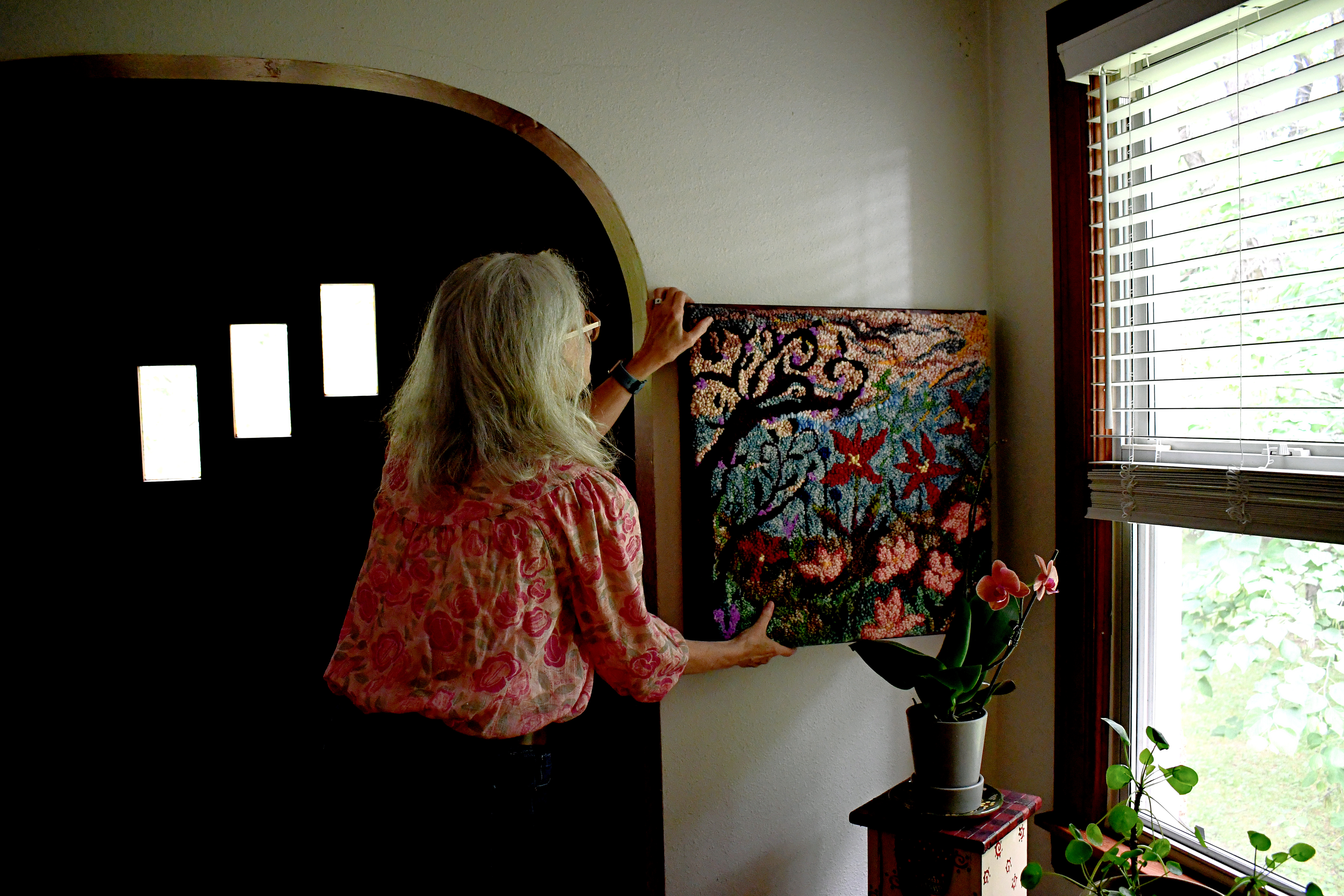
Stewart was interested, too, after seeing those rug-hooked mats some 20 years ago. It led her to take a class, where she got a basic introduction to rug hooking. In days before YouTube videos and other forms of self-teaching, the interest didn’t go anywhere until a year or so later, when another fiber store opened in Springfield.
“The store opened and I saw these fabulous hooked rugs,” says Stewart. “Big hooked rugs that were like fairy tales, Little Bo Peep and all this stuff.”
They were created by artist Tammy Burks, Stewart says, and the duo later became great friends.
“Her creative sensitivity was really similar to mine,” she says. “The rug hooking is a primitive art form, and I like that, I like the old look. But she was really into color and a more modern look, and I really liked that as well.”
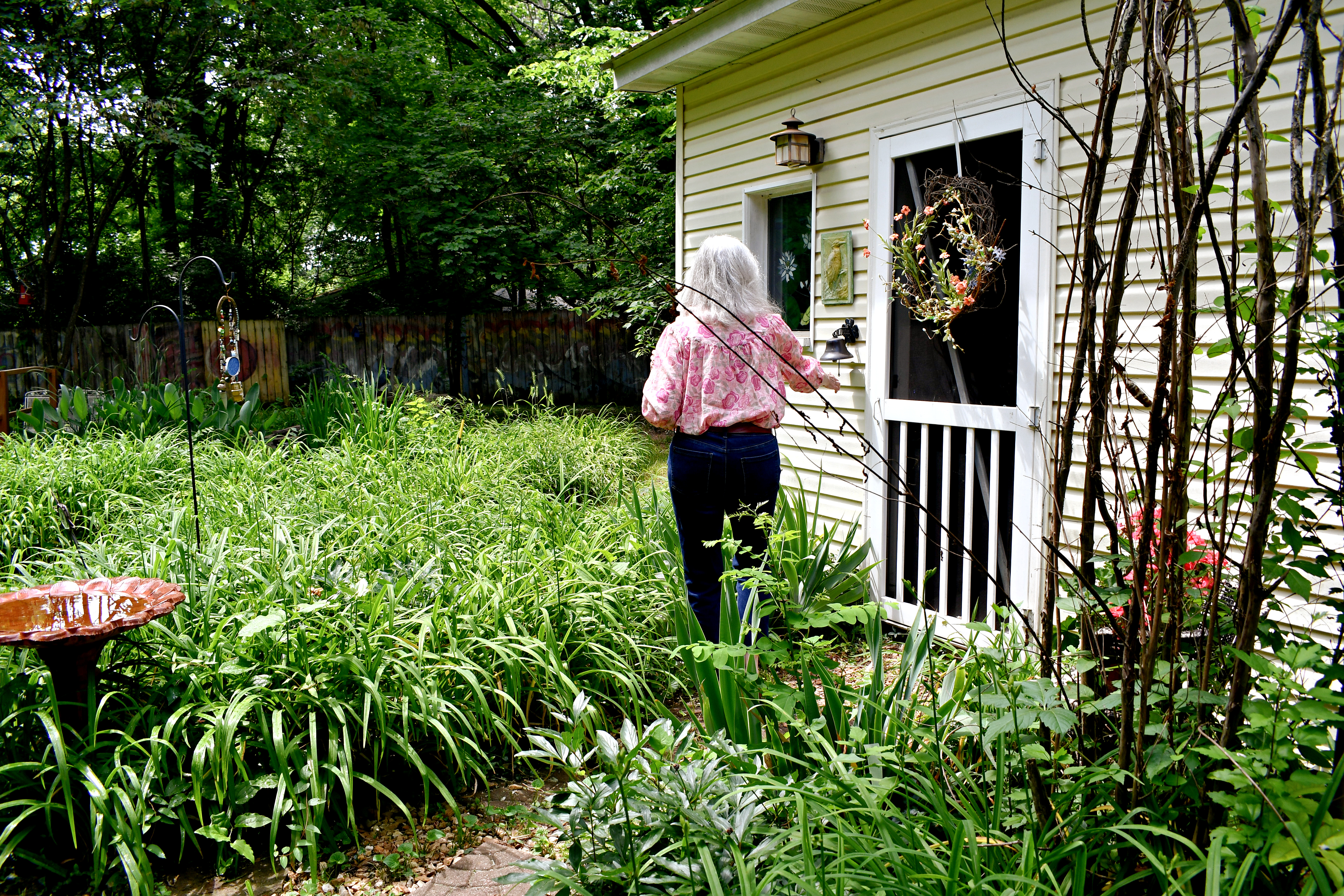
Stewart walks out to her studio, an outbuilding a few feet from her native-stone Springfield home, where she lives with her husband Jim Mayfield, a photographer.
The couple’s secluded, tucked-away cottage is a regular destination for deer, birds and other wildlife — giving inspiration to both Mayfield’s photos and Stewart’s creations.
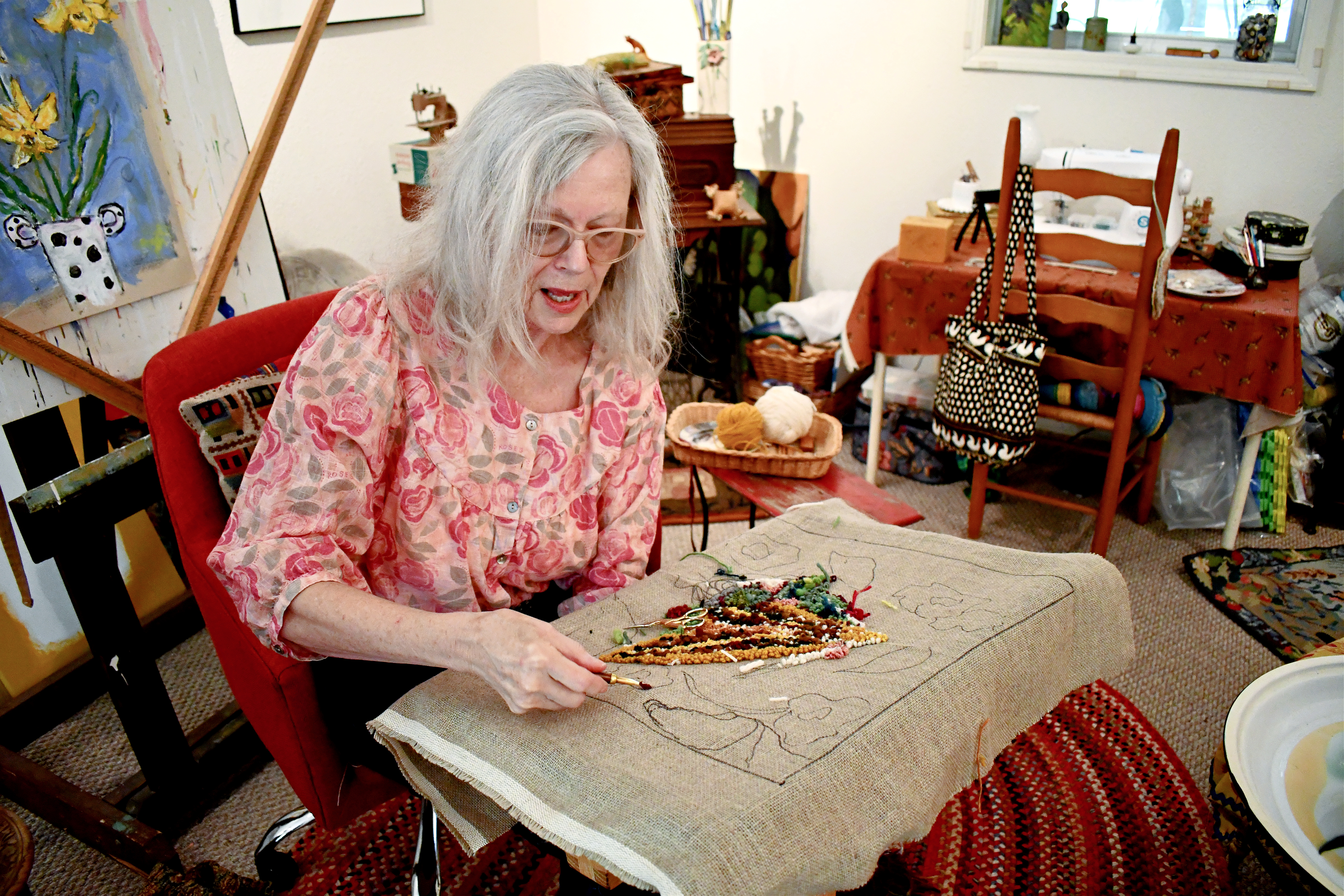
Stewart sits near a frame where her current rug hooking project is in progress. She holds a pencil-sized hook — similar to a crochet hook, but designed for rug hooking — in her hand, and begins to pull colorful yarn through the piece of linen in small loops, creating a picture as she goes.
“When I use the yarn, what I do is — you can go down through the hole, and you pull it up,” she says. “So my hand’s holding underneath, and then this is all we have to know how to do.”
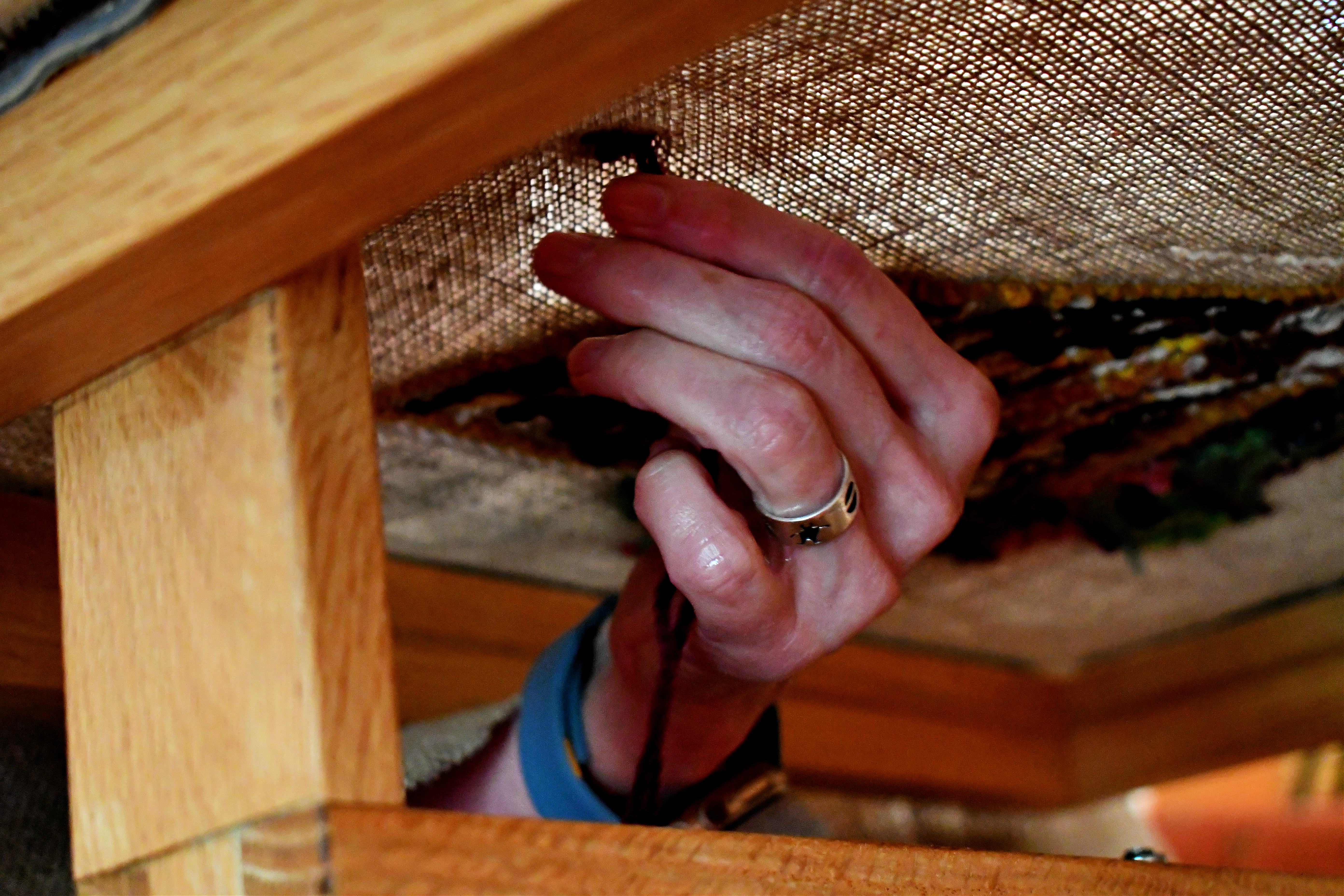
By moving the strands up, and up, and up again, she gradually colors in vibrant, puzzle-like pictures, each filled with hundreds of little “pieces” through loops of yarn.
“Some people say they kind of kiss; they kind of bump up by each other,” says Stewart.
Her work spans a variety of images and themes, but often brings happy colors together to create vibrant pictures of flowers, cats and images that feel like textured puzzles.
Sometimes these works end up as wall hangings — or as rugs, as they were originally intended to be — but that’s not all. Stewart is a painter and weaver, in addition to creating bags and pillows and even an ottoman cover from her rug-hooking work.
“Most of my ideas have come from living right here in this house,” she says. “Seriously, it's just stuff out there; the flowers, and we have a lot of foxes. I get ideas from Jim's photos. Mostly natural stuff. I just like doing flowers and animals.”
Sometimes Stewart follows patterns, but more often than not, her designs are her own.
“I found that I get a pattern, then I'd start drawing on it and changing it a little bit,” she says. “Then I'd look at the pattern and think, ‘Well, I could do that anyway.’ So I started buying linen, and then drawing what I wanted to draw.
“I don't like a whole lot of lines on it. I do it all with the wool. So I started just drawing my own thing. And kind of approaching it like a painting.”
Given the amount of time and resources it takes to create these works, Stewart doesn’t sell many pieces these days. Instead, she prefers to think of it as a labor of love and give it away to people she knows will enjoy it.
“If I sell a bag, I hate asking more than like $75 for this realistically,” says Stewart. “And yet the hours that took me to do it and stuff. It's kind of like, ‘Well, I'd rather just give it to a friend than sell it for $75.’”
The Ozark Mountain Rug Hookers Guild is hosting a free class in connection with the Springfield-Greene County Library District on Aug. 12. More details will be available in the coming weeks, including during the Ozark Empire Fair, where the guild will distribute info.

